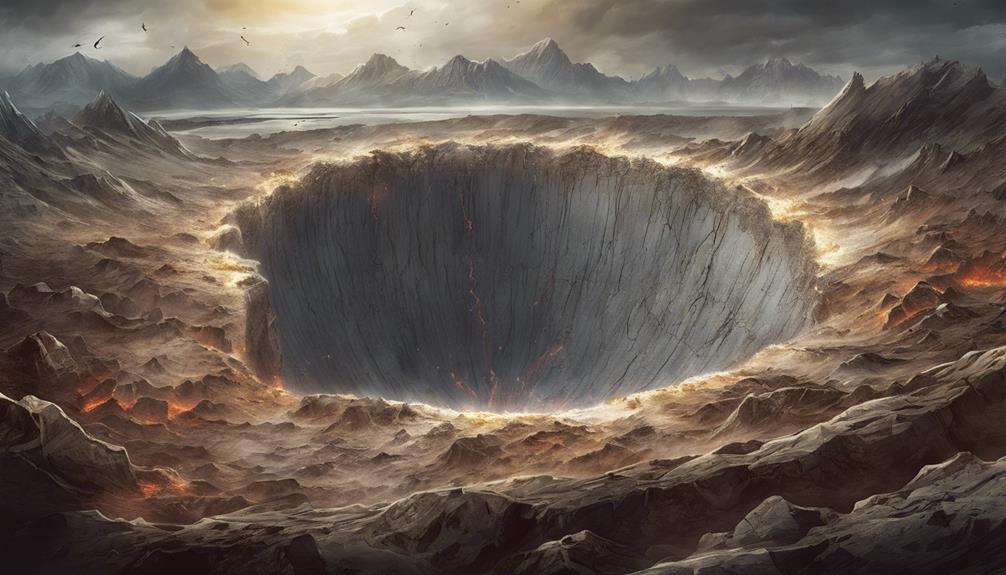Earthquakes, the result of complex geological processes, are fascinating yet potentially catastrophic events that continue to intrigue scientists and researchers worldwide. The fundamental question of what causes these seismic disturbances has long been the subject of study and debate, with various factors contributing to their occurrence. From the shifting of tectonic plates to the subtle movements along fault lines, understanding the origins of earthquakes is essential in not only unraveling the mysteries of our planet but also in safeguarding against their destructive impact.
Key Takeaways
- Earthquakes result from tectonic plate movements and stress accumulation.
- Plate boundaries, especially subduction zones, are major earthquake hotspots.
- Fault types like normal, reverse, and strike-slip influence earthquake dynamics.
- Seismic waves, energy release, and fault movements are fundamental to earthquake occurrences.
Earth's Internal Forces

What fundamental geological processes drive the generation of seismic activity on Earth's surface? Earth's internal forces, including the movement of tectonic plates and interactions along faults, play a crucial role in the occurrence of earthquakes. The Earth's lithosphere is divided into several large plates that float on the semi-fluid asthenosphere below. As these plates move relative to each other, they can create immense pressure and stress along their boundaries. When this stress exceeds the strength of the rocks, it causes sudden movements along fractures known as faults, releasing seismic energy in the form of earthquakes.
The movement of rock masses along faults due to the internal forces within the Earth's crust is a significant contributor to seismic activity. Subduction zones, where one tectonic plate is forced beneath another, also result in intense seismic events. The complex interplay of mantle convection, plate movements, and fault interactions driven by Earth's internal forces ultimately leads to the generation of earthquakes.
Plate Tectonics Overview
The theory of plate tectonics elucidates the dynamic movement and interactions of Earth's lithospheric plates, shaping the planet's geology and driving various geological processes. Plate tectonics is a fundamental concept in understanding the Earth's structure and the occurrence of earthquakes. Key points to consider regarding plate tectonics and earthquakes include:
- Plates in Motion: Earth's lithosphere is divided into large plates that float on the semi-fluid asthenosphere below. These plates are in constant motion, interacting at their boundaries.
- Driving Forces: Plate movements are primarily driven by heat convection currents in the mantle. These currents cause the plates to move, leading to geological activities such as earthquakes.
- Geological Consequences: The interactions and collisions of tectonic plates result in the formation of mountain ranges, volcanic eruptions, and earthquakes. Earthquakes occur when accumulated stress along faults is suddenly released due to plate movements.
Understanding the mechanisms behind plate tectonics is crucial for comprehending the occurrence of earthquakes and other geological phenomena on Earth's surface.
Tectonic Plate Movements

Tectonic plate movements play a fundamental role in shaping Earth's geology and are the primary drivers behind seismic activity worldwide. The Earth's outer shell is divided into several large tectonic plates that constantly shift and interact with each other. These interactions lead to earthquakes when plates slide past, collide, or pull apart, generating immense stress along fault lines. The sudden release of this built-up stress results in seismic waves that propagate through the Earth, causing ground shaking. Plate boundaries, such as the infamous San Andreas Fault, are hotspots for earthquake activity due to the intense plate interactions occurring there. Understanding the dynamics of tectonic plates is crucial for predicting and studying earthquakes, as it provides insights into where and when seismic events are likely to occur. By examining these plate movements, scientists can better comprehend the mechanisms behind earthquakes and work towards mitigating their impact on society and infrastructure.
Divergent Boundaries
Within Earth's lithosphere, divergent boundaries manifest as regions where tectonic plates move apart, facilitating the creation of new crust. At these boundaries, earthquakes occur due to the stress caused by the separation of plates. The earthquakes that happen at divergent boundaries differ from those at other types of plate boundaries in terms of their intensity and frequency. Here are some key points to understand the relationship between earthquakes and divergent boundaries:
- Mild to Moderate Quakes: Earthquakes at divergent boundaries are generally mild to moderate in intensity, as the movement of plates is usually not as abrupt or forceful as at other types of boundaries.
- Crustal Stretching: The separation of tectonic plates at divergent boundaries leads to crustal stretching and faulting, contributing to the occurrence of earthquakes.
- Magmatic Activity: Magma rising to fill the gap created by plate separation can trigger volcanic activity, which also plays a role in the seismic events at divergent boundaries.
Convergent Boundaries
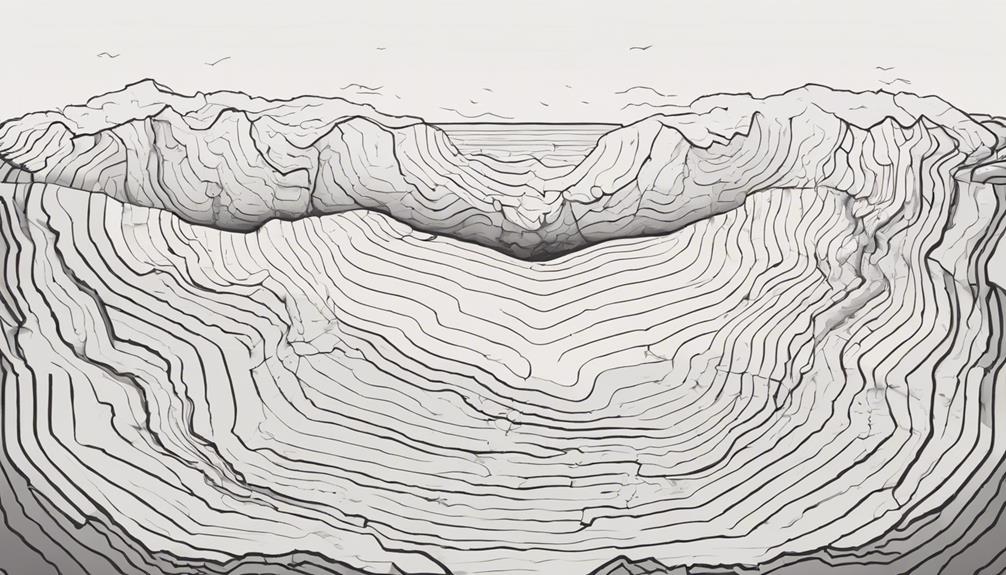
At convergent boundaries, the intense collision of tectonic plates results in significant pressure and friction, leading to seismic activity. These boundaries are characterized by the subduction of one plate beneath another, creating subduction zones. As the descending plate sinks into the mantle, immense pressure builds up, eventually causing earthquakes. The seismic events at convergent boundaries are notably powerful due to the massive energy release resulting from the interaction of plates.
One of the most infamous regions where convergent boundaries are prevalent is the Pacific Ring of Fire. This area encircling the Pacific Ocean is known for its high frequency of earthquakes and volcanic eruptions, all attributed to the converging tectonic plates.
Moreover, deep-focus earthquakes can occur at convergent boundaries. These quakes happen when subducted plates break and release energy deep beneath the Earth's surface. Such events can lead to particularly strong and destructive seismic activity, making convergent boundaries significant zones for earthquake generation.
Transform Boundaries
Transform boundaries are crucial zones in the Earth's crust where tectonic plates grind past each other. The interaction at these boundaries causes seismic activity, primarily earthquakes, as stress accumulates and is eventually released. Understanding the fault movement explanation, plate boundary dynamics, and stress release process is essential in comprehending the seismic events generated at transform boundaries.
Fault Movement Explanation
The horizontal sliding of tectonic plates at boundaries known as transform boundaries initiates the accumulation of stress along faults, ultimately leading to seismic activity.
- Stress Accumulation: The plates' movement causes stress to build up along faults as they grind past each other.
- Fault Slippage: When the stress surpasses the frictional forces holding the rocks together, the fault slips, generating seismic waves.
- Earthquake Generation: The sudden release of accumulated stress results in the rapid movement of rocks along the fault, producing seismic waves that propagate through the Earth.
Understanding how transform boundaries and fault movements interact provides valuable insights into the mechanisms behind earthquake occurrence.
Plate Boundary Movement
Plate boundary movement at transform boundaries is a fundamental component of tectonic activity, influencing the occurrence of seismic events through the interaction of tectonic plates. Transform boundaries are characterized by the horizontal movement of tectonic plates alongside each other. This lateral movement leads to friction and stress accumulation along fault lines. As the stress surpasses the frictional resistance, it causes rapid movements, resulting in earthquakes. One notable transform boundary is the San Andreas Fault in California, renowned for its frequent seismic activity. Earthquakes at transform boundaries vary in intensity, ranging from minor tremors to devastating events. Understanding the dynamics of plate movement at transform boundaries is crucial for predicting and preparing for seismic events in these regions.
Stress Release Process
In the context of tectonic activity at plate boundaries, the stress release process plays a crucial role in the generation of earthquakes.
- Stress accumulates along transform boundaries as tectonic plates slide past each other horizontally.
- The gradual build-up of stress leads to strain within the rocks along the fault lines.
- When the stress overcomes the frictional resistance, a sudden release results in earthquakes characterized by lateral motion.
Transform boundaries, where tectonic plates interact horizontally, such as the San Andreas Fault in California, are known for producing powerful earthquakes. These seismic events can cause significant damage and displacement along the fault lines, highlighting the importance of understanding the stress release process at transform boundaries for earthquake hazard assessment.
Subduction Zones
Located at the converging boundaries of tectonic plates, subduction zones are critical geological features characterized by intense pressure and friction resulting from the subduction of one plate beneath another. In these zones, the descending plate is subjected to immense heat and pressure, causing it to melt and form magma. The interaction of these plates generates powerful seismic waves that can trigger devastating earthquakes. The table below highlights key aspects of subduction zones:
| Aspect | Description |
|---|---|
| Plate Movement | One tectonic plate descends beneath another, creating intense pressure. |
| Geological Impact | Results in the formation of magma and can lead to volcanic activity. |
| Earthquake Potential | Subduction zone earthquakes can be highly destructive and trigger tsunamis. |
Subduction zones are notably present in the Pacific Ring of Fire, where a large number of the world's most significant earthquakes occur. The ability of subduction zones to produce deep-focus earthquakes stems from the descent of the subducted plate into the Earth's mantle, highlighting their importance in understanding seismic activity.
Fault Types
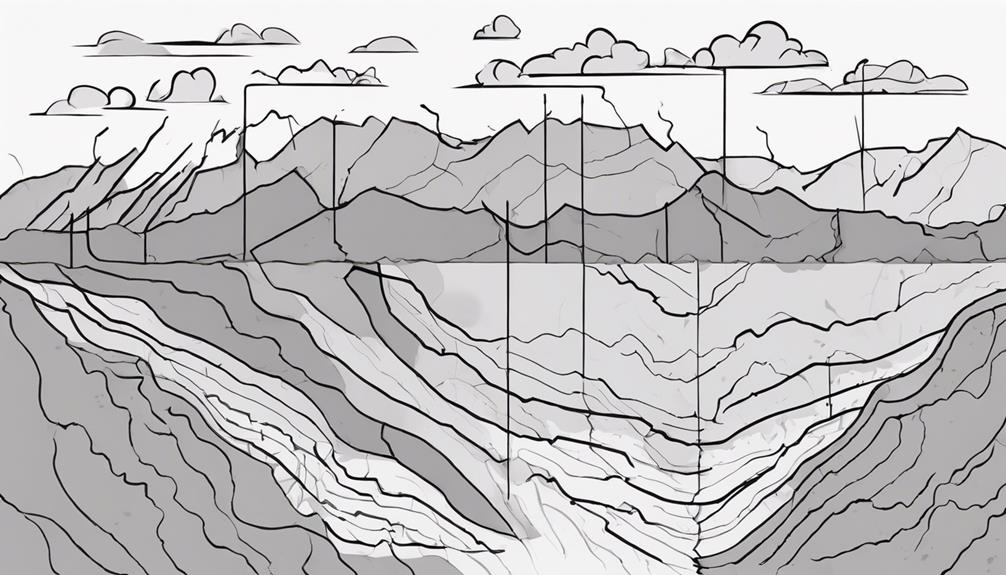
Characterized by distinct movements along fractures in the Earth's crust, fault types play a crucial role in shaping seismic activity and geological landscapes. Understanding these fault types is essential for comprehending the dynamics of tectonic plates and the occurrence of earthquakes.
- Normal faults: In these faults, the hanging wall moves downward relative to the footwall, primarily resulting from tensional forces pulling the crust apart.
- Reverse faults: Reverse faults involve the hanging wall moving upward relative to the footwall, caused by compressional forces acting upon the crust. This movement contributes to the deformation of tectonic plates.
- Strike-slip faults: With horizontal movement along the fault plane due to shear stress, strike-slip faults are associated with lateral displacement of tectonic plates.
These fault types demonstrate the diverse ways in which stress and movement interact within the Earth's crust, highlighting the intricate processes that lead to seismic events. Specifically, reverse faults play a significant role in accommodating the shortening of tectonic plates, affecting the overall stability and behavior of Earth's crust.
Elastic Rebound Theory
The Elastic Rebound Theory elucidates the intricate process by which accumulated stress within rocks is gradually released through sudden movements along fault lines, resulting in earthquakes. This theory underscores the relationship between stress accumulation and the abrupt release of energy, shedding light on the dynamics of seismic events. By understanding the mechanisms behind this phenomenon, scientists can better anticipate and analyze seismic activity, contributing to enhanced earthquake preparedness and risk assessment.
Stress Accumulation Process
In the realm of seismic activity, the Stress Accumulation Process, as elucidated by the Elastic Rebound Theory, stands as a foundational principle explaining the origins of earthquakes.
- Stress builds up in rocks along fault lines due to tectonic forces.
- Rocks deform elastically until they reach their breaking point, triggering seismic waves.
- When the stress surpasses the frictional forces, rocks rebound to their original state, causing an earthquake.
This process of stress accumulation and release is crucial in comprehending earthquake mechanisms and in forecasting seismic events. By understanding this phenomenon, scientists can better predict and prepare for the occurrence of earthquakes, potentially mitigating their impact on society.
Sudden Release of Energy
Following the process of stress accumulation along fault lines, the sudden release of energy, as explained by the Elastic Rebound Theory, plays a pivotal role in the initiation of earthquakes. When rocks along a fault experience stress, they deform elastically until they reach their breaking point, causing them to rapidly snap back into their original position. This sudden movement generates seismic waves that propagate outward from the fault, leading to ground shaking and potential destruction. Understanding this release of energy is crucial in predicting and studying earthquake behavior. The table below illustrates the key role of seismic waves and faults in the process of energy release during an earthquake.
| Key Role of Seismic Waves and Faults |
|---|
| Helps predict earthquake behavior |
| Causes ground shaking |
| Initiates earthquakes |
| Releases stored energy |
| Generates destructive forces |
Seismic Waves Generation
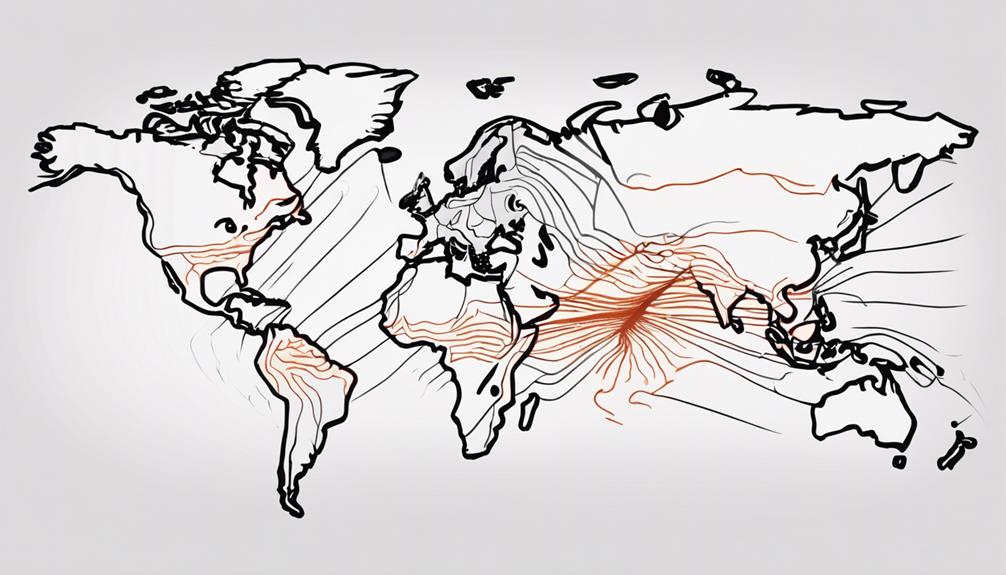
Seismic waves, powerful ripples of energy unleashed during seismic events, play a crucial role in the propagation of earthquake forces through the Earth's layers. When an earthquake occurs, these waves are generated by the sudden release of energy and travel through the Earth in all directions from the earthquake's focus. To understand seismic waves better, consider the following:
- P waves (primary waves): These are the fastest seismic waves and can travel through solids, liquids, and gases due to their compressional motion.
- S waves (secondary waves): Following P waves, S waves are slower and can only travel through solids because they propagate through shearing actions.
- Surface waves: These are the slowest seismic waves and cause the most damage to structures on the Earth's surface due to their complex motion patterns.
Focus and Epicenter
The focus of an earthquake lies beneath the Earth's surface, marking the origin of seismic energy release. Correspondingly, the epicenter represents the point on the Earth's surface directly above this focus. Understanding the depth of the focus and the location of the epicenter is crucial in assessing the impact and potential damage caused by seismic waves.
Depth of Focus
An earthquake's depth of focus, also known as the hypocenter, plays a crucial role in determining the intensity of shaking experienced at the Earth's surface. The seismic waves generated by an earthquake interact with the Earth's layers differently based on the depth of focus, affecting the overall impact of the event. Understanding the depth of focus provides valuable insights into seismic activity and its potential consequences.
- Seismic waves travel varied paths and speeds depending on the depth of the earthquake's focus.
- Different depths of focus give rise to varying intensities of shaking at the Earth's surface.
- The distribution of energy released during an earthquake is influenced by the depth of the focus point.
Seismic Epicenter
The precise identification of the seismic epicenter, in relation to the depth of focus and the subsequent ground shaking effects, is a fundamental aspect of earthquake analysis and assessment. When an earthquake occurs, seismic waves travel outward from the focus, causing vibrations felt at the epicenter and beyond. The epicenter is located on the Earth's surface directly above the seismic focus, where the rupture of rocks initiates the release of energy. The depth of the seismic focus beneath the surface influences the intensity and spread of shaking experienced at the epicenter. Understanding the relationship between the seismic waves, tectonic plates, and the epicenter location is crucial for predicting and mitigating the impact of earthquakes on populated areas.
Human-Induced Earthquakes
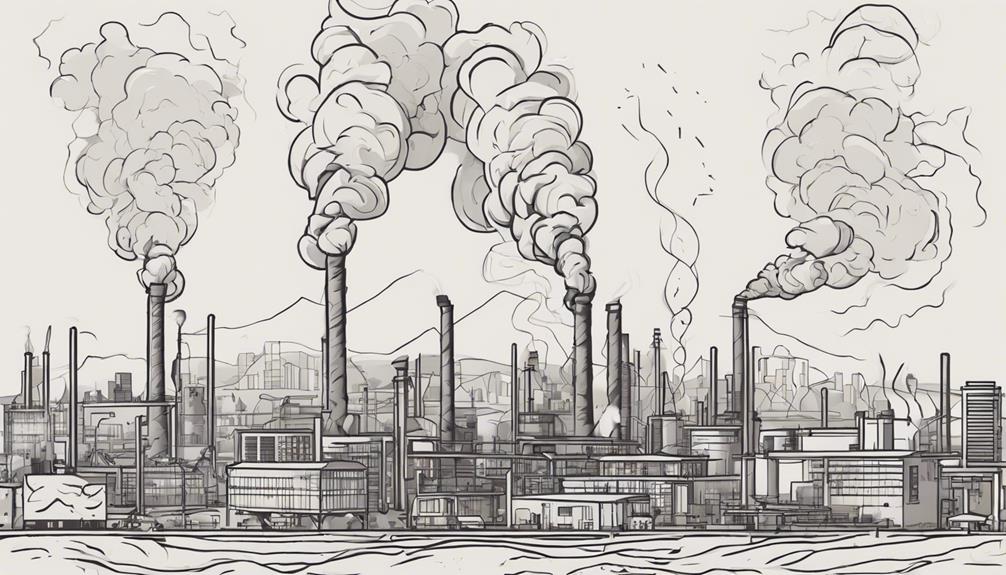
Human activities, such as mining and hydraulic fracturing, can trigger seismic events known as human-induced earthquakes. These events are caused by injecting fluids into the ground, altering subsurface stress conditions, and increasing pressure on faults. Factors such as the depth and rate of fluid injection, as well as the proximity of faults, significantly influence the occurrence of human-induced earthquakes. To mitigate risks and ensure seismic safety, monitoring and regulating activities that can induce earthquakes are crucial. These earthquakes are distinct from natural seismic events caused by the movement of tectonic plates and underground explosions. Understanding the mechanisms behind human-induced earthquakes is essential for implementing effective preventive measures. By studying the impact of human activities on the Earth's crust, scientists can better predict and manage the seismic risks associated with these anthropogenic activities.
Volcanic Activity Impact
Triggered by volcanic activity, earthquakes can result from the intense pressure and stress exerted within the Earth's crust. When magma moves beneath the Earth's surface, it can generate significant force, leading to the displacement of rock layers and the creation of fractures. This movement can cause volcanic earthquakes, which are often shallow in depth and concentrated near volcanic zones. Volcanic eruptions can also induce seismic activity by triggering the formation of new faults or reactivating existing ones. The interaction between the magma and surrounding rocks can produce intense pressure changes, resulting in seismic shifts that manifest as earthquakes.
Monitoring volcanic activity plays a crucial role in understanding the potential impact of volcanic-induced earthquakes. By observing changes in gas emissions, ground deformation, and seismic patterns, scientists can assess the likelihood of volcanic eruptions and associated seismic events. This monitoring is essential for mitigating risks to populations living near active volcanic regions and improving our overall understanding of the complex relationship between earthquakes and volcanic activity.
Seismology and Monitoring Systems
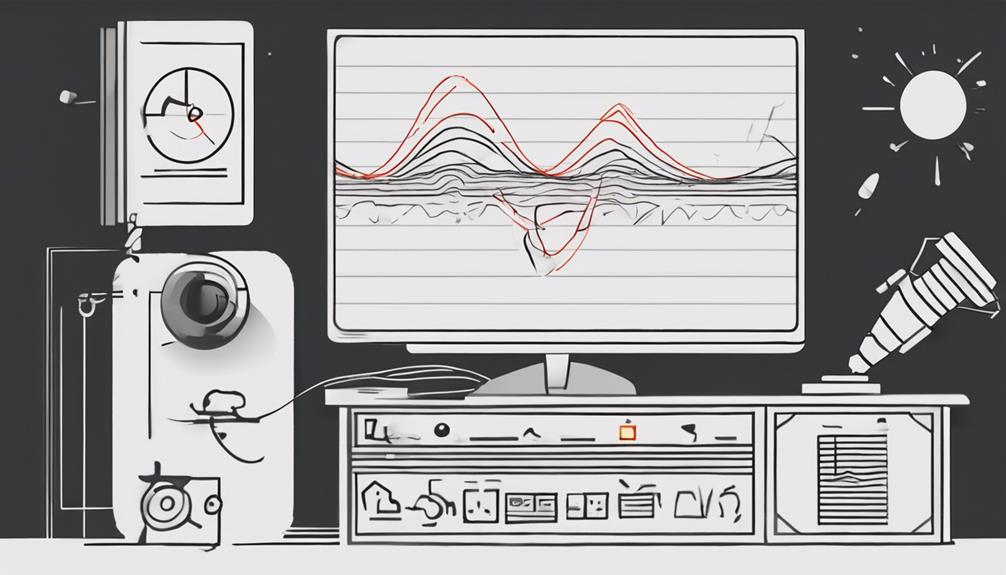
Studying seismic waves and implementing monitoring systems are fundamental aspects of seismology, essential for comprehending Earth's internal dynamics. Seismology involves analyzing the behavior of seismic waves generated by earthquakes to gain insights into the structure and movement of tectonic plates. Monitoring systems, such as seismometers, play a crucial role in recording ground movements and detecting earthquake activity in real-time. These systems form seismic networks that utilize multiple stations to triangulate earthquake locations and determine their magnitude accurately. Advanced technologies like GPS and satellite imagery further enhance earthquake monitoring by providing precise measurements and aiding in the development of early warning systems. By analyzing real-time data collected from monitoring systems, scientists can identify seismic patterns, improve earthquake prediction models, and ultimately enhance our ability to mitigate the impact of seismic events on society.
Frequently Asked Questions
What Is the Main Cause of an Earthquake?
The primary cause of earthquakes lies in the intricate movements of tectonic plates along fault lines. Stress accumulation at plate boundaries leads to sudden releases of energy, generating seismic waves. These fault movements, triggered by interactions between plates, play a pivotal role in the occurrence of earthquakes. Understanding how plate activities influence fault behavior is crucial in comprehending the underlying mechanisms behind seismic events.
Can You Trigger an Earthquake?
Human activities can indeed trigger earthquakes, particularly through processes like hydraulic fracturing (fracking) and deep well fluid injections. The correlation between human impact and seismic activity is evident, with induced earthquakes posing risks to infrastructure. Understanding the interplay of tectonic plate movements and fracking techniques is crucial for managing induced seismicity. This intricate relationship underscores the necessity for robust mitigation strategies to address potential earthquake hazards effectively.
Where Do Most Earthquakes Occur?
Most earthquakes occur along tectonic plate boundaries, where the Earth's crustal plates interact. These interactions create areas of increased seismic activity, such as fault lines and oceanic ridges. Notably, the Pacific Ocean's ring of fire is a prominent earthquake belt. While some earthquakes do occur within plate interiors, the majority happen at plate boundaries. Understanding these locations aids in assessing seismic risks and implementing necessary preparations for potential earthquake events.
Which Country Has the Most Earthquakes?
When considering seismic hotspots and fault lines globally, certain regions stand out for their frequency of earthquakes. Countries positioned along tectonic plate boundaries experience heightened seismic activity due to ongoing plate movements. This leads to a higher occurrence of earthquakes, making these nations particularly prone to such natural events. Understanding the correlation between fault lines and seismic activity is crucial in assessing earthquake risk in different parts of the world.
Conclusion
In the intricate dance of Earth's internal forces, earthquakes are a dramatic manifestation of the ongoing tectonic plate movements. Like a delicate balance between opposing forces, the release of energy in seismic events serves as a reminder of the dynamic nature of our planet. Through seismology and monitoring systems, we strive to understand and prepare for these natural phenomena, ensuring the safety and resilience of our communities in the face of Earth's powerful forces.
